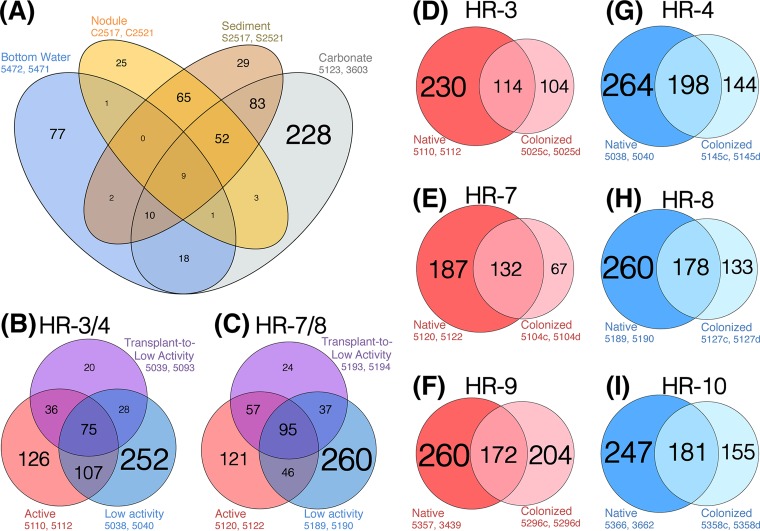FIG 4 .
Comparison of OTU97 overlap among various samples and treatments. In order to ensure equal depth of sampling across each substrate type, two representative samples of each substrate were chosen randomly (sample numbers are given). The number in each region denotes the number of OTUs, and text size is proportional to OTU count (as is circle size for panels D to I). (A) OTU overlap between the four native seep habitat substrates examined in this study: sediments, nodules, carbonates, and bottom water. In order to minimize geographic bias in the analysis, samples were chosen from active stations at Hydrate Ridge south (the only exception was bottom water sample 5472, which was from an HR-South low-activity station). Note that carbonates host the richest OTU diversity (see the collector’s curve in Fig. 2A), including a large number of OTUs which are distinct to carbonates. Carbonates share more OTUs with sediments and nodules than with bottom waters, possibly indicative of an origin within the sediment column and subsequent exhumation and exposure at the seafloor. Bottom waters contribute more OTUs to carbonates than to either sediments or nodules—consistent with the recovery of our carbonates from directly on the seafloor. (B and C) OTU overlap of active and low-activity control carbonates, and transplant-to-low-activity carbonates, for the HR-3/-4 and HR-7/-8 transplant experiments. Transplant-to-active carbonates were not included due to their low sample number (n = 1 each for HR-3/-4 and HR-7/-8). (D to I) OTUs observed in native carbonate samples versus colonized carbonate samples as a function of Hydrate Ridge Station. Stations were included only if they received colonization carbonate deployments and we had recovered native carbonates from the same station (these criteria excluded HR-1, HR-2, HR-6, HR-11, and the Southeast Knoll). Left column (red [D to F]) are active stations, right column (blue [G to I]) are low-activity stations. In each case, the darker color represents the native carbonates and the lighter color represents the colonized carbonates. In most cases, the majority of recovered OTUs from colonization carbonates were also present in native carbonates.

